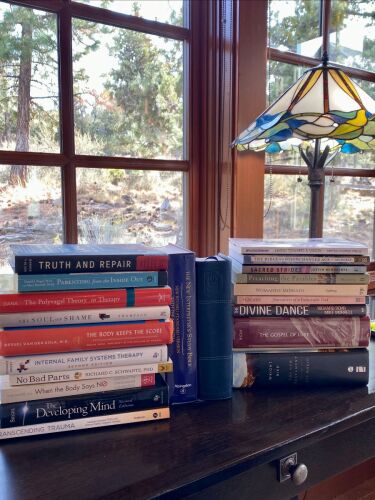 Are you wondering if it’s possible to restore calm and hopefulness in the face of unrelenting challenges?
Are you wondering if it’s possible to restore calm and hopefulness in the face of unrelenting challenges?
Navigating changes you didn’t choose—in your relationships, at work, at church, in the world—provokes chaos inside. Emotions veer from anger to grief to anxiety. Brief gasps of air punctuate a pervasive sense of drowning. Your body fluctuates between being primed for action and the heaviness of bone-deep resignation.
It’s time to shift from being in the storm to be with the parts of you who are overwhelmed by circumstances. You have what they need.
The fearful, despairing members of your internal family have a narrow field of vision. They see threats, not solutions. They need to feel seen, safe, soothed, and secure.
You have resources—including compassion, curiosity, calm, and connection—and the physiology necessary to access them. Two experts discovered similar things.
Dr. Richard Schwartz, the developer of the Internal Family Systems (IFS) model, discovered we all possess what he (following the lead of clients) calls “Self.” “Client after client, the same mindfully curious, calm, confident, and often even compassionate part would pop up out of the blue, and that part seemed to know how to relate internally in a healing way.”
Self draws on healing resources including curiosity, connection, compassion, calm, confidence, creativity, courage, and clarity to meet the needs of all parts of the system.
Self bears the image of God. Self is the heart, soul, mind, and strength who leads your inner family along with the Spirit.
Our physiology enables us to access these resources. When Self leads, our nervous system shifts from reacting to threats—a state of either hyperarousal (fight or flight) or hypoarousal (freeze)—to a state supporting social engagement. “In this state, our heart is regulated, our breath is full, we take in the faces of friends, and we can tune into conversations…We see the ‘big picture’ and connect to the world and the people in it.”
While this describes our ability to engage with our external world and relationships, the same is true for our inner relationships. When Self leads, you can tune into the needs of your internal family members, offering them the safe, soothing presence that helps restore calm.
So, how do you restore Self-leadership in your inner system?
Start with a few slow, deep breaths. This sends a message of safety to the whole nervous system. Next, imagine creating a welcoming space for meeting with members of your inner family.
You’re the compassionate witness, noticing the different members of your internal family. They hold thoughts, emotions, images, and sensations.
Allow them to be just as they are without needing them to change. Imagine compassion, kindness, and patience flowing to each of them from your heart.
Your calm, compassionate presence will soothe the members of your inner family.
They will feel safe knowing they are not alone. If it feels right for you, breathe in more of the Spirit. Self leads in harmony with the Spirit, providing an inexhaustible supply of love in all its forms.
Sometimes, it will be enough to hang out. Other times, you’ll notice a particularly persistent part who needs more attention. One of the greatest gifts you can give is curiosity. Simply ask, “What do you need?”
I love that Jesus asked a blind man, “What do you want me to do for you?” (Mark 10:51). He didn’t presume; the curiosity was genuine. Genuine curiosity helps members of our internal family feel seen and hopeful.
You have God-given resources available for whatever challenge you’re navigating.
You can shift from being in the storm to being with distressed members of your inner family. And, as they relax, you will have even more access to the resources you need.




Leave A Comment